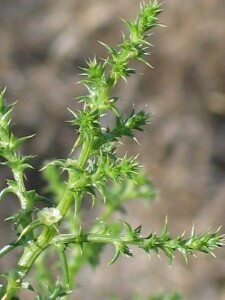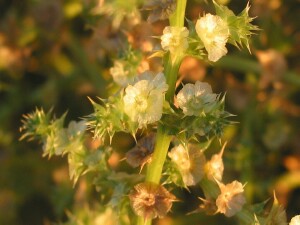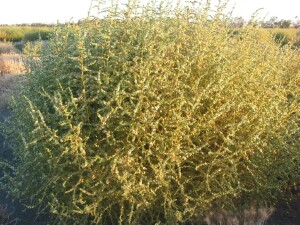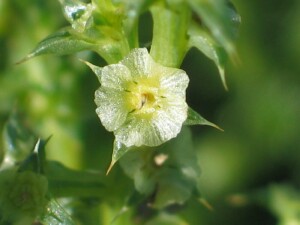Buckbush
Back | Salinity Indicator Plants Home | Common name home | Scientific name home | Photo Gallery | Glossary
| Buckbush photos | Family: Saltbush (Chenopodiaceae) |
| Scientific Name: | Salsola tragus (poss. syn. Salsola kali) | 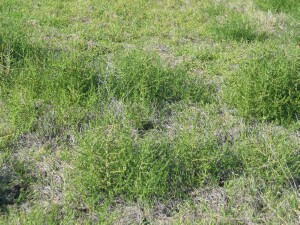 Small plants of Buckbush Photo: A J Brown | ||||||
Other Common Names: | Prickly Salwort, Prickly Saltwort, Roly-poly, Prickly Roly-poly, Soft Roly-poly, Russian Thistle, Prickly Russian Thistle, Tumbleweed. | |||||||
Status: | Probably native to Europe and Asia and naturalised in Australia but uncertain (see comments). | |||||||
Plant Description: | An erect and rounded annual or biennial herbaceous shrub with hairless and somewhat succulent stems when fresh. When mature, bushes break off at ground level and are subject to rolling away by the wind; often becoming entangled in other vegetation or on fences. Leaves are without stalks, linear, slender and stiff, 10-30 mm long and 2-3 mm wide. Flowers occur in the angles between stem and leaves and are subtended by rigid, sharply pointed, small bracts. The pale green to creamy pink fruiting body is 5-9 mm diameter and consists of five wings | |||||||
Habitat: | Found in both non-saline and saline habitats on swamps, lake beds, shrub-lands and grasslands. Also on sand dunes and mudflats in near coastal sites.
| |||||||
Comments: | There currently exists considerable confusion over the taxonomy of Salsola species within Australia. Salsola is a genus of 100-150 species around the world. Naturalised populations of Salsola tragus (or S. kali or both if considered separate) in North America and Australia are thought to have originated in Eurasia. However, early explorers reported Buskbush in the Australian outback, well before settlement of these regions. Recent studies in Western Australia have suggested that some, if not all, of these inland populations are of Salsola australis and probably a truly native species. The taxonomic and native status of eastern Australia populations are unknown. The older species name of ‘kali’ originates from the Arabic ‘al qaly’ (from kali) which is the basis for the word alkali. The plant contains up to 30% sodium carbonate and was an important source of soda ash, until the early 19th century, for the manufacture of glass, soap and other products. Because of their oxalate content, the plants are potentially toxic to grazing livestock. The species is generally considered to be a weed, particularly in agricultural areas. | |||||||
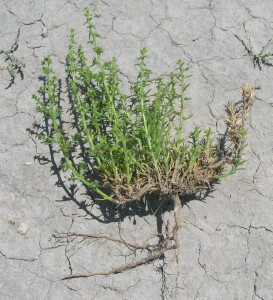 Small Buckbush plant showing tap-root Photo: A J Brown | 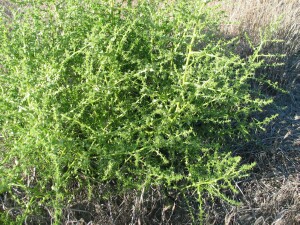 Young Buckbush shrub Photo: A J Brown |
|
|
|
|

